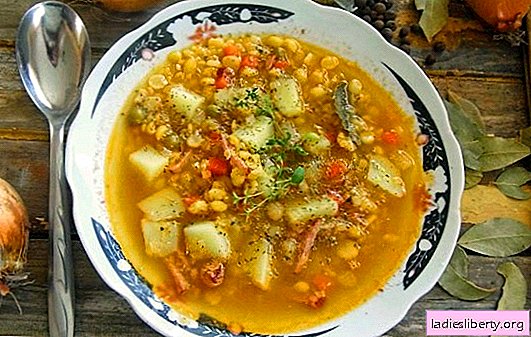
As a rule, planting an apple tree in autumn is practiced in two cases - planting inexpensive seedlings from a nursery or replanting adult garden trees. Such a landing has its advantages and disadvantages. Let's try to figure out how to do it right.
The choice of seedlings for planting apple trees in the fall from the nursery
Usually in nurseries adhere to the following cycle of growing seedlings: in the fall and winter, seeds are statified and the wild plants are planted in the greenhouse, in the spring they are planted, and by the fall they receive ready-made planting material. Therefore, you can buy good grafted seedlings in autumn at a lower price than in spring, as often the nursery needs to free up space for new trees.
How to choose the right seedlings? First of all, you need to pay attention to the place of vaccination. Vaccination is most often done by budding, that is, a kidney of a varietal tree is grafted onto a wild bird. Externally, the vaccination site looks like a small stump with a bend. It is better if the grafting site is approximately 10-15 cm away from the root neck, such seedlings will even take root well when the soil subsides, and the grafting site will be above the ground. The seedling itself in this case is a stick about 60-70 cm long, without branches. Some unscrupulous sellers sell seedlings of wild game without vaccination, so be sure to pay attention to whether there is a vaccination or not.
It is also worth looking at the presence of external damage to the bark, and if the seedlings are sold without land, the integrity of the root system.
Photo of a good grafted seedling, the place of vaccination is visible:

Dates of planting apple seedlings in autumn
If you planted a sapling of an apple tree in the spring, then in summer the land will sag under the sapling due to the fact that it will dry out. As a result, the root collar may be below ground level. In autumn, it will dry out and sag much less. This is one of the main advantages of autumn planting.
Planting should be done at least two weeks before the first frost. In the middle zone of Russia it is usually in September-October. Planting earlier than mid-September is not recommended, because due to the long daylight hours and high temperatures, the growth of leaves and shoots may begin, which will freeze in winter, this will be difficult for a seedling, it may not take root and dry out.
The technology of planting apple seedlings in autumn
First, a shallow hole is dug up to a depth of about 50-60 cm. A layer of humus, good black earth or well-rotted manure is laid in it, so thick that the root neck of the seedling, which will be planted from above, would be higher than the soil level when planting. The root neck is easy to determine - look where the roots begin to grow in the seedling, the root neck will be about 4 cm above this place.
Then a seedling is placed in the pit. It is held with one hand, and the other is poured into the hole with the ground. In this case, the seedling will be slightly recessed under the weight of the earth down, it needs to be pulled a little so that the root neck is always above the ground. It is better if the earth is poured with a small mound. The ground around the seedling is trampled so that it is at a slight elevation above the soil level, about 2 cm. It is necessary to trample well.
After planting, seedlings are watered. It is advisable to add small amounts of potash fertilizers to the water for irrigation. Watered from the calculation of one bucket of water per seedling. No holes or indentations should be made around the seedlings - if water flows, water slowly from a watering can.
After this, the seedling is tied with a layer of roofing material from rodents, and the earth around the seedling is mulched to a thickness of about 10 cm with a layer of loose earth or synthetic materials. Sawdust and peat are not recommended - they can be used to bring wood-beetle beetles or microorganisms that are painful for trees from the forest. It is not necessary to tie young sapling rods - usually older plants are tied.
Photo of planted apple tree:

Transplanting adult apple tree seedlings in autumn
It is best to initially plant trees so that in the future do without replanting them. Nevertheless, if you plan to erect some buildings on the site of apple trees, you can resort to a transplant.
A tree no older than 5 years is suitable for transplanting. Before transplanting, they wait until the leaves almost completely fall off the trees, or at least turn yellow. You cannot start a transplant before this moment. Before transplanting, the orientation of the tree branches relative to the cardinal points is approximately noted - in the future, when transplanting, it is advisable to plant it approximately in the same way as it grew before.
They carefully dig it out of the ground, keeping the layer of earth around the root neck at a distance of about 40 cm in all directions intact. Thick long roots have to be chopped off. You should get almost a hemisphere with a diameter of about 70-80 cm.

The tree is carefully transferred together to the place of new planting. They dig a hole of such a size that the root system of the transplanted tree fits completely there, and there would still be room for about 20 cm in all directions. The pit is filled partially with humus or well-rotted manure. Fill with layers of 10 cm, each layer is well rammed. Then they dig a hole in the shape of the root bulb of the transplanted tree, so that the root neck is about 5 cm higher than the soil level. The seedling is placed in a hole and planted, carefully trampling with feet on all sides. Then, for the winter, the bark of the tree is covered with rodents only and the earth is mulched with a layer of about 15-20 cm.
After planting, the tree is watered with water of at least 5 buckets. You need to add potash fertilizers to the water. In the future, watering is continued until the first frost.
Errors in planting apple trees in autumn and their consequences
• The most common mistake is the incorrect position of the root neck. It is necessary to determine very precisely where the root neck will be after planting the tree. To do this, it is convenient to use a board that is laid across the pit when landing. The thickness of the board is 2.5 cm, it is at this distance from the ground that the root neck should be located - under the top edge of the board.
• If the root neck is set too low, the bottom of the tree trunk is in the ground, and after planting it will sing. As a result, peeling of the bark and death of the tree is possible, and if the tree takes root, it will bear fruit much later than during normal planting.
• On the contrary, if the root neck is located above ground level, in the future such a tree will experience problems in the summer due to lack of moisture. It will bear fruit rather poorly, especially if these are early varieties that yield in July-August.
• The second mistake - insufficient quality trampling of the earth during planting. In this case, a layer of loose soil is formed, which will soon settle under the action of moisture, and the position of the tree will be much lower than the original. The same problems can occur as with a low-lying root neck.
• When transplanting adult trees, often, to save energy when carrying, choose a smaller root system than is required. This can’t be done - the tree not only loses most of its original root system, as a result of which it can dry out, but it is also likely that the wind can tear it out of the ground, as the transplanted apple tree will have insufficient support mass below.











